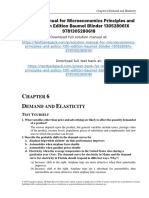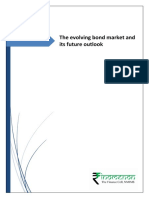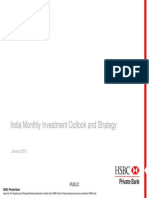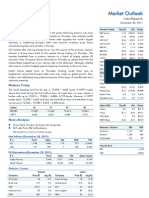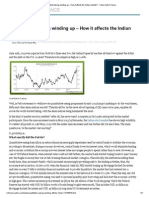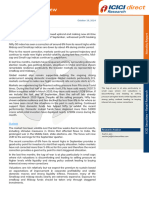India Market Outlook Aug 2013
India Market Outlook Aug 2013
Uploaded by
sindu_lawrenceCopyright:
Available Formats
India Market Outlook Aug 2013
India Market Outlook Aug 2013
Uploaded by
sindu_lawrenceCopyright
Available Formats
Share this document
Did you find this document useful?
Is this content inappropriate?
Copyright:
Available Formats
India Market Outlook Aug 2013
India Market Outlook Aug 2013
Uploaded by
sindu_lawrenceCopyright:
Available Formats
India Market Outlook
31st July 2013
RBI in the limelight
Content Executive Summary Macro Bonds Equity Currency Pg 1 Pg 1 Pg 2 Pg 2 Pg 3 Executive Summary RBI announces monetary tightening measures to stem rupee fall. Bond yields spike across the board. Banking stocks slide. INR recovers partially, though only temporarily.
Indian Tactical Asset Allocation August 2013 Asset Class Equity Bonds Commodities Cash
Source: Standard Chartered
Macro The RBI seems to be in the limelight again as it announced a series of monetary tightening measures this month. The measures were inspired by the weakening rupee, which hit an all time low against the dollar in June. The move follows the Brazilian and Indonesian example of a rate hiking regime to curb currency volatility. The RBI announced its first set of policy measures on 15 th July, essentially aimed at curtailing the prevalent arbitrage activities in the foreign exchange market. The RBI announced restrictions on banks overnight borrowing facility and increased penal rates for these overnight borrowings beyond a certain threshold. By raising borrowing costs and restricting access to relatively cheap money, the RBI intends to reduce any speculation that may intensify the already prevalent and elevated rupee volatility. The immediate impact on overnight rates post the first policy announcement was limited, as the banks slipped through the cracks based on certain loopholes. The hawkish RBI was quick to clamp down on these gaps and announced another round of measures on 23rd July, eventually paving the way for a 300 bps rise in overnight rates. A key point to note is that the RBI has preferred not to tamper with either the repo rate or the CRR, indicating that the currently announced measures are temporary in nature and do not signal a reversal of broader monetary policy direction. On a positive note, the WPI index (wholesale price based inflation index) for June remained relatively restrained at 4.85% y/y, recording only a marginal increase from Mays 4.7% y/y. A sharp deterioration in producer pricing power and a still weak economic outlook are amongst the key factors that are likely to keep the WPI index in check over the longer term as these factors eventually outweigh concerns on recent increase in agricultural & fuel prices.
12 Month View Overweight Neutral Underweight Neutral
RBI: Repo, CRR held as Call rates spike
Repo Rate, Call Rate Index, Cash Reserve Ratio (CRR) (%) 11 10 9 8 7 6 5 4 3 2-Jul-13
9-Jul-13 CRR
16-Jul-13 Call Rate
23-Jul-13
30-Jul-13
Repo Rate
Source: Bloomberg, Standard Chartered
The RBI, in its policy announcement, kept key rates unchanged. This was in line with our expectations as recent measures have enabled the RBI to drive up short-term rates (notably the overnight rates) effectively, hence reducing the need for additional policy changes. The RBI may also have been partly constrained on account of a temporary upward blip in the WPI.
This commentary reflects the view of the Wealth Management Group of Standard Chartered Bank
Benchmark Yields: Yield spikes now value buys
Benchmark 10 year & 4 year GoISec yield (%) 9.50 9.00 8.50 8.00 7.50 7.00 6.50 2-Jul-13
Bonds RBI spooked the bond markets across the board as the recent RBI monetary tightening measures announced led to yield spikes across bond tenors. As highlighted in our Market Watch publication (released on 23rd July), the rise in yields has been more pronounced for the shorter term bonds which has resulted in an inversion of the yield curve i.e. shorter term bonds now offer higher yields than longer term ones. While this inversion may have led to near term pain for those invested in shorter term securities, the pain is relatively less than those invested in duration securities. To validate with an example, the 12 month total return (as on 26th July) for the benchmark 4 Y GoISec index was about 9.2% whereas the 12 month total return (as on 26th July) for the benchmark 10 Y GoISec index was about 0.48%. The numbers validate the benefit of holding short term securities as wed highlighted in the last two editions of the India Market Outlook.
9-Jul-13
16-Jul-13
23-Jul-13 GIND 4 Y
30-Jul-13
GIND 10 Y Source: Bloomberg, Standard Chartered
Given the recent yield gains in shorter term bonds, we consider the recent correction an opportunity to accelerate purchases in bonds with short maturity profiles (4 years and less). The prevailing yield on a benchmark 4 Y GoISec index currently quotes at about 8.7% and on a benchmark 1 Y GoISec index at about 9.1%. These levels indicate suitable investment levels for those comfortable with moderate levels of volatility. For the extremely conservative and those uncomfortable with the prevailing volatility surrounding interest rates, one can lock-in prevailing high interest rates by investing in bonds with 1 to 3 years of maturity. Reiterating the message from last weeks Market Watch, the recent correction in the benchmark 10 year GoISec seem overdone, representing oversold levels in our view. Weve seen the benchmark 10 Y GoISec yields retrace to 8.1% levels from a recent high of 8.4%. As the market gradually factors in rupee risks as well as supply concerns over the next few weeks, longer dated securities (notably the benchmark 10 Y GoISec) can be potentially rewarding over the year for those willing to accept some volatility in the interim. In summary, we reinforce our view from last weeks Market Watch: Risk-reward trade-off favours taking advantage of the prevailing high yields, we recommend accelerating purchases as the recent rise in yields seems somewhat overdone, in our view. Short maturity yields are at reasonably attractive levels, both from a historic as well as risk-adjusted perspective. Long duration is an opportunity for those willing to withstand volatility. Near term key risk on account of further rupee weakness remains. Equity The Indian equity markets rose for the majority of July, taking cues from the U.S. Feds announcements earlier in the month as Emerging markets across the globe rallied in tandem. Weakness prevailed towards the end of the month as RBI measures raised short term borrowing costs, mounting concerns on already fragile Indian economic growth.
Sensex: Jittery June
Sensex closing values, 12 Month Forward P/E multiple (RHS) 25000 25
20000
20
15000
15
Greater concerns persist on account of the potential fallout of RBI measures on the banking sector, (which comprises of a significant portion of the broader Indian indices) which has already been under pressure owing to poor credit growth and dwindling quality of assets, not to mention the mark to market losses on duration GoISecs for some of the larger public sector banks. Near term we see a case for heightened volatility as markets gradually price in these near term concerns, notably driven by the banking sector. Some green shoots in the form of an improving an improving trade deficit, subdued WPI numbers and a healthy monsoon should support the equity markets. From a technical perspective, the Sensex is likely to find support between the 18,000 and 18,500 mark and resistance between the 20,000 and 20,500 mark in the near to medium term. From a valuations perspective, the 1 year forward P/E is currently quoting at about 14.5x, still below the long term historical average of 15x.
10000
10
5000
0 3-Aug-08 3-Aug-09 3-Aug-10 3-Aug-11 Sensex 12M Forward P/E
0 3-Aug-12 5 Y P/E Average
Source: Bloomberg, Standard Chartered
This commentary reflects the view of the Wealth Management Group of Standard Chartered Bank
INR: Temporary respite
USD INR spot 62 61 60 59 58 57 56 55 54 53 52 31-Dec-12 28-Feb-13 30-Apr-13 30-Jun-13
Currency The recent steps by the RBI underscore its determination to curtail rupee volatility and stabilise the INR. While the initial bounce in the USD versus EM currencies in late Q1 and early Q2 was welcomed by the authorities in many EM countries, the mid-year extension of these USD gains has prompted steps to foster FX stability across a broad range of EM countries. The RBI has acted decisively, and the announced measures will likely prompt a rebound in the INR in the immediate near term. However, a sustained tightening of domestic liquidity conditions is a rather indirect way of calming FX markets. It risks simply boosting domestic interest rates and macroeconomic instability, while failing to tackle the underlying fundamental reasons for the deterioration in Indias current account balance. Absence of concrete, structural measures to fund the current account deficit will likely pave the way for a re-emergence of upward pressure on USD-INR.
Source: Standard Chartered
This commentary reflects the view of the Wealth Management Group of Standard Chartered Bank
Disclosure Appendix This document is not research material and it has not been prepared in accordance with legal requirements designed to promote the independence of investment research and is not subject to any prohibition on dealing ahead of the dissemination of investment research. This document does not represent the views of Standard Chartered Bank, particularly those of the Global Research function. Standard Chartered Bank is incorporated in England with limited liability by Royal Charter 1853 Reference Number ZC18. The Principal Office of Standard Chartered Bank is situated in England at 1 Basinghall Avenue, London, EC2V 5DD. Standard Chartered Bank is authorised by the Prudential Regulation Authority and regulated by the Financial Conduct Authority and Prudential Regulation Authority. In Dubai International Financial Centre (DIFC), the attached material is circulated by Standard Chartered Bank DIFC on behalf of the product and/or Issuer. Standard Chartered Bank DIFC is regulated by the Dubai Financial Services Authority (DFSA) and is authorised to provide financial products and services to persons who meet the qualifying criteria of a Professional Client under the DFSA rules. The protection and compensation rights that may generally be available to retail customers in the DIFC or other jurisdictions will not be afforded to Professional Clients in the DIFC. Banking activities may be carried out internationally by different Standard Chartered Bank branches, subsidiaries and affiliates (collectively SCB) according to local regulatory requirements. With respect to any jurisdiction in which there is a SCB entity, this document is distributed in such jurisdiction by, and is attributable to, such local SCB entity. Recipients in any jurisdiction should contact the local SCB entity in relation to any matters arising from, or in connection with, this document. Not all products and services are provided by all SCB entities. This document is being distributed for general information only and it does not constitute an offer, recommendation, solicitation to enter into any transaction or adopt any hedging, trading or investment strategy, in relation to any securities or other financial instruments. This document is for general evaluation only, it does not take into account the specific investment objectives, financial situation, particular needs of any particular person or class of persons and it has not been prepared for any particular person or class of persons. Opinions, projections and estimates are solely those of SCB at the date of this document and subject to change without notice. Past performance is not indicative of future results and no representation or warranty is made regarding future performance. Any forecast contained herein as to likely future movements in rates or prices or likely future events or occurrences constitutes an opinion only and is not indicative of actual future movements in rates or prices or actual future events or occurrences (as the case may be). This document has not and will not be registered as a prospectus in any jurisdiction and it is not authorised by any regulatory authority under any regulations. SCB makes no representation or warranty of any kind, express, implied or statutory regarding, but not limited to, the accuracy of this document or the completeness of any information contained or referred to in this document. This document is distributed on the express understanding that, whilst the information in it is believed to be reliable, it has not been independently verified by us. SCB accepts no liability and will not be liable for any loss or damage arising directly or indirectly (including special, incidental or consequential loss or damage) from your use of this document, howsoever arising, and including any loss, damage or expense arising from, but not limited to, any defect, error, imperfection, fault, mistake or inaccuracy with this document, its contents or associated services, or due to any unavailability of the document or any part thereof or any contents. SCB, and/or a connected company, may at any time, to the extent permitted by applicable law and/or regulation, be long or short any securities, currencies or financial instruments referred to in this document or have a material interest in any such securities or related investments, or may be the only market maker in relation to such investments, or provide, or have provided advice, investment banking or other services, to issuers of such investments. Accordingly, SCB, its affiliates and/or subsidiaries may have a conflict of interest that could affect the objectivity of this document. This document must not be forwarded or otherwise made available to any other person without the express written consent of SCB. Copyright: Standard Chartered Bank 2013. Copyright in all materials, text, articles and information contained herein is the property of, and may only be reproduced with permission of an authorised signatory of, Standard Chartered Bank. Copyright in materials created by third parties and the rights under copyright of such parties are hereby acknowledged. Copyright in all other materials not belonging to third parties and copyright in these materials as a compilation vests and shall remain at all times copyright of Standard Chartered Bank and should not be reproduced or used except for business purposes on behalf of Standard Chartered Bank or save with the express prior written consent of an authorised signatory of Standard Chartered Bank. All rights reserved. Standard Chartered Bank 2013.
THIS IS NOT A RESEARCH REPORT AND HAS NOT BEEN PRODUCED BY A RESEARCH UNIT.
This commentary reflects the view of the Wealth Management Group of Standard Chartered Bank
You might also like
- Target Corporation: Ackman Versus The Board: FM2 Case Study AnalysisNo ratings yetTarget Corporation: Ackman Versus The Board: FM2 Case Study Analysis6 pages
- Microeconomics Principles and Policy 13th Edition Baumol Solutions Manual Download100% (19)Microeconomics Principles and Policy 13th Edition Baumol Solutions Manual Download4 pages
- Bearmach Reservedelskatalog Til LR Discovery100% (1)Bearmach Reservedelskatalog Til LR Discovery68 pages
- Debt Mutual Fund Picks: Macro Data Round UpNo ratings yetDebt Mutual Fund Picks: Macro Data Round Up6 pages
- Helping You Spot Opportunities: Investment Update - October, 2012No ratings yetHelping You Spot Opportunities: Investment Update - October, 201256 pages
- India Monthly Investment Outlook and Strategy: January 2013No ratings yetIndia Monthly Investment Outlook and Strategy: January 201313 pages
- Market Insight Q3FY12 RBI Policy Review Jan12No ratings yetMarket Insight Q3FY12 RBI Policy Review Jan123 pages
- C O M P A N Y P R O F I L E: Achal Gupta Managing Director & Chief Executive OfficerNo ratings yetC O M P A N Y P R O F I L E: Achal Gupta Managing Director & Chief Executive Officer61 pages
- RBI Policy Review Oct 2011 Highlights and RecommendationNo ratings yetRBI Policy Review Oct 2011 Highlights and Recommendation7 pages
- Week Ended September 21, 2012: Icici Amc Idfc Amc Icici BankNo ratings yetWeek Ended September 21, 2012: Icici Amc Idfc Amc Icici Bank4 pages
- Market Review Future Outlook Feb2012-SbiNo ratings yetMarket Review Future Outlook Feb2012-Sbi6 pages
- Tracking The World Economy... - 13/08/2010No ratings yetTracking The World Economy... - 13/08/20103 pages
- RBI Monetary Policy Review, 17th June 13No ratings yetRBI Monetary Policy Review, 17th June 135 pages
- Icici Prudential Mutual Fund Rbi Second Quarter Review of Monetary Policy 2010-11No ratings yetIcici Prudential Mutual Fund Rbi Second Quarter Review of Monetary Policy 2010-114 pages
- Quantitative Easing Winding Up - How It Affects The Indian Markets - Yahoo India FinanceNo ratings yetQuantitative Easing Winding Up - How It Affects The Indian Markets - Yahoo India Finance3 pages
- Case Builds For A Rate Cut: Liquidity Conditions Remain EasyNo ratings yetCase Builds For A Rate Cut: Liquidity Conditions Remain Easy3 pages
- Weekly Mutual Fund and Debt Report: Retail ResearchNo ratings yetWeekly Mutual Fund and Debt Report: Retail Research15 pages
- Assignment of Buisness Enviroment MGT 511: TOPIC: Changes in Monetary Policy On Banking Sector or IndustryNo ratings yetAssignment of Buisness Enviroment MGT 511: TOPIC: Changes in Monetary Policy On Banking Sector or Industry9 pages
- Key Highlights:: Inflationary Pressures Overrides Downside Risks To GrowthNo ratings yetKey Highlights:: Inflationary Pressures Overrides Downside Risks To Growth6 pages
- Fixed Income Market - Encouraging Signs AheadNo ratings yetFixed Income Market - Encouraging Signs Ahead2 pages
- Reserve Bank of India and Its Impact On The Indian Economy Post 1991 (Interest Rates, Exchange Rates and Inflation)No ratings yetReserve Bank of India and Its Impact On The Indian Economy Post 1991 (Interest Rates, Exchange Rates and Inflation)7 pages
- Economy One Week Scanner For IAS Prelims 20150% (1)Economy One Week Scanner For IAS Prelims 201599 pages
- Tracking The World Economy... - 09/09/2010No ratings yetTracking The World Economy... - 09/09/20102 pages
- Quantitative Easing (QE) Is An UnconventionalNo ratings yetQuantitative Easing (QE) Is An Unconventional16 pages
- Epaperpdf 23052011 22main Edition-Pg13-0No ratings yetEpaperpdf 23052011 22main Edition-Pg13-01 page
- RBI Springs Surprise, Cuts Repo by 50 Bps by Dinesh Unnikrishnan & Anup RoyNo ratings yetRBI Springs Surprise, Cuts Repo by 50 Bps by Dinesh Unnikrishnan & Anup Roy5 pages
- Annual Report For Policy Holders Economic Update20170824 071040No ratings yetAnnual Report For Policy Holders Economic Update20170824 0710404 pages
- Acumen - RBI Monetary Policy Review - December 2019No ratings yetAcumen - RBI Monetary Policy Review - December 20194 pages
- Electricity Reform in Argentina: Lessons For Developing CountriesNo ratings yetElectricity Reform in Argentina: Lessons For Developing Countries32 pages
- Bun Bakery - Finanical Improvement PlanNo ratings yetBun Bakery - Finanical Improvement Plan11 pages
- Shaheed Sukhdev College of Business StudiesNo ratings yetShaheed Sukhdev College of Business Studies27 pages
- Tt6602 Financial Management For Textile and Apparel L T P CNo ratings yetTt6602 Financial Management For Textile and Apparel L T P C5 pages
- Market Structure: Characteristics and TypesNo ratings yetMarket Structure: Characteristics and Types29 pages
- Flashcards - Theme 1 Introduction To Markets and Market Failure - Edexcel (A) Economics A-LevelNo ratings yetFlashcards - Theme 1 Introduction To Markets and Market Failure - Edexcel (A) Economics A-Level155 pages
- Optical Retail Software - SAP Business One With Ivend RetailNo ratings yetOptical Retail Software - SAP Business One With Ivend Retail5 pages
- The Deckel SO Grinder Buyer's Guide: by Phil Kerner, The Tool & Die Guy100% (1)The Deckel SO Grinder Buyer's Guide: by Phil Kerner, The Tool & Die Guy6 pages
- Target Corporation: Ackman Versus The Board: FM2 Case Study AnalysisTarget Corporation: Ackman Versus The Board: FM2 Case Study Analysis
- Microeconomics Principles and Policy 13th Edition Baumol Solutions Manual DownloadMicroeconomics Principles and Policy 13th Edition Baumol Solutions Manual Download
- Helping You Spot Opportunities: Investment Update - October, 2012Helping You Spot Opportunities: Investment Update - October, 2012
- India Monthly Investment Outlook and Strategy: January 2013India Monthly Investment Outlook and Strategy: January 2013
- C O M P A N Y P R O F I L E: Achal Gupta Managing Director & Chief Executive OfficerC O M P A N Y P R O F I L E: Achal Gupta Managing Director & Chief Executive Officer
- RBI Policy Review Oct 2011 Highlights and RecommendationRBI Policy Review Oct 2011 Highlights and Recommendation
- Week Ended September 21, 2012: Icici Amc Idfc Amc Icici BankWeek Ended September 21, 2012: Icici Amc Idfc Amc Icici Bank
- Icici Prudential Mutual Fund Rbi Second Quarter Review of Monetary Policy 2010-11Icici Prudential Mutual Fund Rbi Second Quarter Review of Monetary Policy 2010-11
- Quantitative Easing Winding Up - How It Affects The Indian Markets - Yahoo India FinanceQuantitative Easing Winding Up - How It Affects The Indian Markets - Yahoo India Finance
- Case Builds For A Rate Cut: Liquidity Conditions Remain EasyCase Builds For A Rate Cut: Liquidity Conditions Remain Easy
- Weekly Mutual Fund and Debt Report: Retail ResearchWeekly Mutual Fund and Debt Report: Retail Research
- Assignment of Buisness Enviroment MGT 511: TOPIC: Changes in Monetary Policy On Banking Sector or IndustryAssignment of Buisness Enviroment MGT 511: TOPIC: Changes in Monetary Policy On Banking Sector or Industry
- Key Highlights:: Inflationary Pressures Overrides Downside Risks To GrowthKey Highlights:: Inflationary Pressures Overrides Downside Risks To Growth
- Reserve Bank of India and Its Impact On The Indian Economy Post 1991 (Interest Rates, Exchange Rates and Inflation)Reserve Bank of India and Its Impact On The Indian Economy Post 1991 (Interest Rates, Exchange Rates and Inflation)
- RBI Springs Surprise, Cuts Repo by 50 Bps by Dinesh Unnikrishnan & Anup RoyRBI Springs Surprise, Cuts Repo by 50 Bps by Dinesh Unnikrishnan & Anup Roy
- Annual Report For Policy Holders Economic Update20170824 071040Annual Report For Policy Holders Economic Update20170824 071040
- Acumen - RBI Monetary Policy Review - December 2019Acumen - RBI Monetary Policy Review - December 2019
- Electricity Reform in Argentina: Lessons For Developing CountriesElectricity Reform in Argentina: Lessons For Developing Countries
- Tt6602 Financial Management For Textile and Apparel L T P CTt6602 Financial Management For Textile and Apparel L T P C
- Flashcards - Theme 1 Introduction To Markets and Market Failure - Edexcel (A) Economics A-LevelFlashcards - Theme 1 Introduction To Markets and Market Failure - Edexcel (A) Economics A-Level
- Optical Retail Software - SAP Business One With Ivend RetailOptical Retail Software - SAP Business One With Ivend Retail
- The Deckel SO Grinder Buyer's Guide: by Phil Kerner, The Tool & Die GuyThe Deckel SO Grinder Buyer's Guide: by Phil Kerner, The Tool & Die Guy

